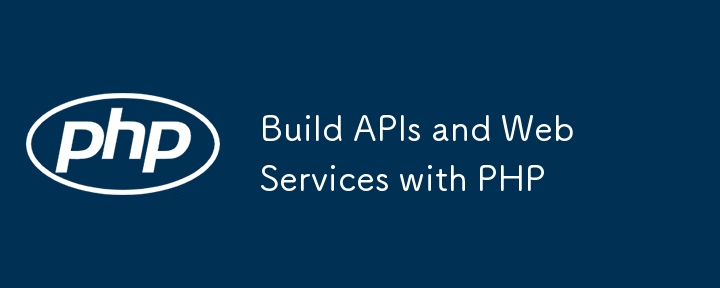
Building APIs and web services using PHP involves the following steps: setting up a PHP environment, installing PHP, the Apache server, and the mod_php module. Create API, write PHP scripts to handle requests and return responses. Create web services, use PHP frameworks or pure PHP to create servers. Practical case: Build a user registration API, process POST requests, verify data and create users, and return a successful registration response.

Building PHP APIs and Web Services
PHP is a widely used scripting language, especially suitable for building Web applications and APIs . This article explains how to build APIs and web services using PHP and provides a practical example to illustrate the process.
Setting up a PHP environment
Before you start creating APIs and web services, you need to make sure you have a PHP environment installed and configured. You can follow these steps:
// 安装 PHP sudo apt-get update sudo apt-get install php // 安装 Apache Web 服务器 sudo apt-get install apache2 // 启用 mod_php 模块 sudo a2enmod php // 重启 Apache sudo systemctl restart apache2
Create your API
In order to create an API, you need to write a PHP script that handles requests and returns responses. You can use the following code snippet as a reference:
<?php
// 设置头部
header('Content-Type: application/json');
// 获取请求方法
$method = $_SERVER['REQUEST_METHOD'];
// 根据请求方法进行路由
switch ($method) {
case 'GET':
// 处理 GET 请求
break;
case 'POST':
// 处理 POST 请求
break;
default:
// 处理其他请求
break;
}
// 返回响应
echo json_encode(['message' => 'Hello world!']);
?>Creating your web service
To create a web service, you can use a PHP framework such as Laravel or Symfony . Alternatively, you can use pure PHP to create the web service. The following is a code snippet for creating a Web service using pure PHP:
<?php
// 创建一个监听本地主机 8080 端口的 HTTP 服务器
$server = new swoole_http_server('localhost', 8080);
// 设置服务器回调函数
$server->on('request', function (swoole_http_request $request, swoole_http_response $response) {
// 处理请求
$response->end('Hello world!');
});
// 启动服务器
$server->start();
?>Practical case: Building a user registration API
The following is how to use PHP to build a simple Practical case of user registration API:
register.php. <?php
// 设置头部
header('Content-Type: application/json');
// 获取请求方法
$method = $_SERVER['REQUEST_METHOD'];
// 处理 POST 请求
if ($method == 'POST') {
// 获取请求数据
$data = json_decode(file_get_contents('php://input'), true);
// 验证请求数据并创建一个用户
$user = new User();
$user->setUsername($data['username']);
$user->setPassword($data['password']);
$user->save();
// 返回响应
echo json_encode(['message' => 'User registered successfully']);
} else {
// 处理其他请求
echo json_encode(['message' => 'Invalid request method']);
}
?>Conclusion
Building APIs and web services using PHP is a simple process and this article provides the necessary steps and code examples. Through the above practical cases, you can quickly start your own PHP API or Web service development.
The above is the detailed content of Build APIs and Web Services with PHP. For more information, please follow other related articles on the PHP Chinese website!




